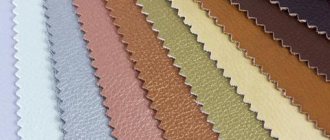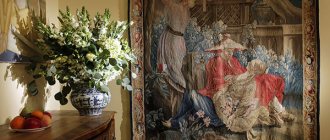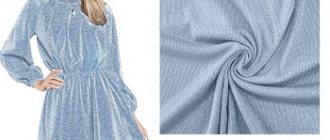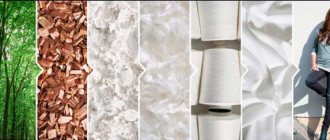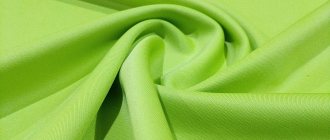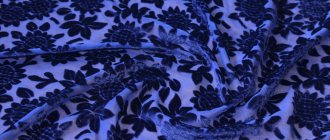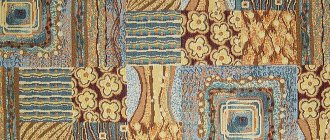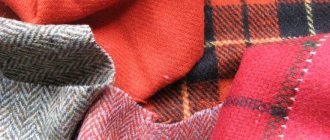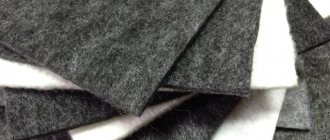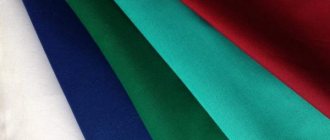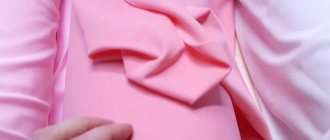23.01.2020
Satin, shiny, silky - these epithets are often awarded to satin, which will be discussed in this article. This is a cotton fabric that resembles silk in appearance. It is very smooth, touching it leaves your fingers feeling fresh and cool. Satin is considered a “noble” material, and previously it was called “cotton silk” - because of its similarity to the latter.
History of appearance
The satin material owes its appearance to the Chinese. It was from distant China that in the 12th century, Arab merchants began to export specially woven fabric, made at that time from expensive silk. It is the technology of weaving threads that is called “satin”. The surface had a special gloss. It was incredibly expensive. Festive ritual clothes were sewn from it. The price was so high that only very wealthy people could afford such luxury.
Amazing satin fabric
In the mid-19th century, Europeans began producing the material using new technology, using cotton threads. New products have become accessible to the middle class. It is used for sewing festive dresses and lingerie. The most popular direction is bedding sets. What else can be made from satin - home textiles, tablecloths, curtains, draperies and much more.
Variety of fabrics
Material composition, properties
Initially, the fabric was made from silk, but since the development of the subsequently patented satin technology, the composition of the fabric was changed and began to be made from cotton fiber. Threads can be natural, without the addition of synthetics, or using synthetic materials.
The properties of a fabric are determined by its qualitative composition. Therefore, when you type the following query into a search engine: “what kind of fabric is satin?”, you can get many links to different types of material, and it will all be satin.
Properties and characteristics of satin:
- durability - the fabric successfully withstands up to 200 washes without loss of silkiness and shine, as well as without the appearance of pilling;
- hypoallergenic;
- breathability - the fabric has “breathable” properties;
- hygroscopicity - the fabric absorbs moisture from the surface of the body;
- thermal conductivity - matter maintains body temperature;
- crease resistance - due to the special weaving of the threads, wrinkles do not form on the fabric;
- drapeability - keeps its shape well;
- does not electrify and does not slip;
- softness, silkiness;
- elegant shine.
Important! Properties such as hypoallergenicity, breathability and hygroscopicity are characteristic only of natural fabric, without the addition of synthetic fibers.
Unique properties of the fabric - shine and wrinkle resistance
Manufacturing technology
To make satin fabric, two types of high-quality cotton threads are used. One of them, denser, is used for the base of the fabric, and the other, thin and twisted, is used to form the front side. The fabric gets its famous shine thanks to the twisted thread. The reverse side remains matte.
You might be interested in Description of gauze: types and uses of fabric
Important! Satin weaving has its own peculiarity: a twisted thread is woven into the back through three rows into the fourth. The mercerization process gives satin a more pronounced shine.
Satin weave threads
What standards are used in production? What do they take into account?
Bed linen is often made from satin. State standards determine the values of such a fabric parameter for linen as density. GOST 31307-2005 indicates that this indicator for satin weaving is 110–220, 220–250 and over 250 g/m2.
From GOST 21790-93 we learn about the standards for breaking load and abrasion resistance of finished fabrics.
| Fabric name | Breaking load of a fabric strip measuring 50 × 200 mm, N (kgf), not less | Resistance to abrasion along the plane, cycles, not less | |
| based on | one duck at a time | ||
| Satin weave with surface density, g/m: | |||
| up to 220 incl. | 353 (36) | 618 (63) | 2000 |
| St. 220 – 250 | 392 (40) | 736 (75) | 2500 |
| 250 | 441 (45) | 834 (85) | 3500 |
Varieties by density
The density indicator depends on the number of intertwined threads per 1 cm2 of fabric.
Satin has the following density:
- regular - 85-130 threads; to improve the quality, such satin is mercerized or calendered (passed through heated rollers);
- printed satin - 85-170 threads, threads of different colors are used in weaving;
- printed - 85-170 threads, the design is applied to the finished product;
- jacquard - 170-220 threads, has a double-sided pattern made with a specific weave;
- Mako-satin - from 220 fine threads, very durable fabric of excellent quality.
Description of satin fabric
Satin looks different from other types of fabrics. This is due to a special method of weaving threads. The main part of the material is dense, and the front part is characterized by smoothness and lightness. The reason for this is the use of thinner threads, which, when twisted, create shine in the fabric.
Satin is often confused with calico and poplin. If you look at the drawing more closely, the difference will become obvious. Calico is represented by a pattern in the form of ordinary crosses, while the pattern of satin material is created much more complex. Poplin is made with a particularly important condition, which is the use of threads of different thicknesses.
You might be interested in everything about durable cotton fabric of brown-yellow color (nanki)
Sundress
Classification by origin of fibers
The satin weaving method can be used to make fabric from various fibers.
Varies in composition:
- cotton, made from natural cotton, sometimes called ecosatin;
- mixed, made of cotton and polymer fibers;
- satin-double, fabric used for linings, can consist of several combinations of cotton and viscose threads;
- satin-satin or silk-satin, made of silk and cotton threads;
- crepe-satin, made from cotton and silk threads, natural and artificial silk are used;
- stretch satin is a crepe-satin with the inclusion of lycra for elasticity.
Note! There is another type of fabric - satin-twill, or polysatin. This is a mixed twill weave fabric, similar in composition to certain types of satin, mainly cotton and polyester.
Many people are interested in what kind of satin velvet fabric is this? This is a special fabric that is made from threads with pile. Here's an insulated option for winter.
Velvet fabric in soft peach color
Price scale
The fabric is produced by large factories in Russia, Turkey, China, and Italy. Russian manufacturers offer mixed fabric costing from 180 rubles per meter. Cotton material costs from 250 rubles per meter. Luxury varieties start from 1000 rubles per meter. The cost is influenced by the composition, the presence of a pattern or embroidery.
Chinese satin is considered elite, its price tag starts from 1,500 rubles per meter. Turkish manufacturers also have good quality.
A ready-made set of satin lingerie costs 3–4 thousand rubles. Jacquard and embroidery are more expensive - from 5 thousand rubles.
The material is purchased in specialized sewing stores and ordered via the Internet.
Product care
Much to the happiness of housewives, satin is not a capricious fabric. Bed linen will not lose its silkiness for a long time, and clothes will still delight the eye with bright colors.
The first wash of the product must be carried out based on the care instructions. Fasten all zippers and buttons, and turn the clothes inside out. The washing temperature is usually set at 40°C, cotton mode.
Caring for satin bed linen
Be sure to wash before first use. It is best to do this in the “cotton” mode at 40°C. In the future, for subsequent washes, it is allowed to set the temperature to 90°C. The use of rinse aid is also permitted. It makes the fabric even softer.
You might be interested in Description of the characteristics and appearance of felt fabric: where it is used
Important information! Since satin is virtually wrinkle-resistant, you can avoid the tedious process of ironing all day by carefully hanging your laundry to dry. If you still want to iron the bedding, you must remember that the temperature of the iron should not exceed 90°C. It is better to iron from the wrong side.
Bed linen care
Reviews
Serious changes have occurred in my life, and in order to unwind, I decided to change my home environment. I couldn't afford the renovation, so I chose to replace the textiles and curtains. The seller recommended satin fabric for curtains, since my bedroom is on the sunny side. I am satisfied with the result: the room has been transformed, it has become airy and cozy. Natalya S., 38 years old, Pavlovo
I chose curtains made of satin with a small flower pattern. I was amazed by the clarity of the image: the smallest details of the roses, stamens, and leaves are visible. My girls are delighted: the drawing looks beautiful and does not get lost. And I’m also pleased with the satin, that the curtains were easy to wash and dry. Lyudmila Shch., 29 years old, Samara
My friends and I were selecting curtain material for a home recording studio. Curtains were required to let in light without obscuring it. We didn’t regret choosing saten. The fabric is quite dense, gives a pleasant soft light that does not hit the eyes. Olga Yu., 23 years old, Vladimir
How to choose bed linen
When choosing bed linen, it is better not to skimp on convenience and comfort and choose a fabric with a natural composition of 100% cotton. For sleeping sets, the best choice would be a material with a density of 130 threads per cm2. Since bed linen is in “everyday” demand, we must remember that the denser the fabric, the more durable and wear-resistant the product will be.
Important information! Before purchasing, be sure to unwrap the packaging and touch, touch, and feel the fabric. It’s also worth taking out one item, for example, a pillowcase, and holding it up to the light. A high-quality, solid thing will only let in sunlight or bright electric light. If the outlines of objects are visible, then the material is not dense.
The structure must be homogeneous. If there is a mark on mercerization on the label, this is a strong argument for a positive decision on choice. Smoothness, even silkiness, of the fabric is also a good sign. The roughness of the front side of the product indicates that the product will quickly roll up, pellets will appear and the shine will disappear.
There are several types of fabric from which bed linen is most often made.
Silk satin
This material is a unique combination of silk on the front side of the fabric and cotton on the back, without the addition of artificial fibers. The most durable fabric of truly impeccable appearance, but also the most expensive of all types of satin.
Silk satin bed linen
Printed satin
The thread density is quite high, up to 170 per cm2. On linen made from such satin, the design is applied to the finished product, so the linen looks especially elegant. Underwear with 3D patterns is in great demand. It is obtained by applying an image to fabric using reactive printing. It looks simply amazing!
Crepe satin
A material containing silk, viscose or synthetic threads of special crepe twist.
Printed fabric bed linen
Identifying a fake
To buy a really high-quality satin set, use the following recommendations:
- Try to buy underwear only from trusted sellers, avoid street kiosks and markets where counterfeits are most likely present.
- Read the label. A good material will be 100% cotton, and information about the mercerization of the threads will be an undoubted indication of quality.
- Trust your tactile sensations. The more pleasant and smooth the material is to the touch, the longer it will retain its silkiness.
- Hold the linen in your hands, the heavier it is, the more natural it is.
- Fold the material, real satin will have no creases.
- Check the density of the fabric in the light. The outlines of objects should not be visible through a high-quality canvas.
If you don’t trust your observations, ask friends for recommendations or study information about the bed linen manufacturer on the Internet.
Advantages and disadvantages of bed linen
Its advantages include the following:
- durability and strength - repeated washings practically do not deprive the linen of shine, smoothness and visual appeal;
- Washed items do not need to be ironed; to do this, you need to dry them, carefully straightening them out;
- softness, airiness and comfort for the body;
- does not slip on the mattress due to the dullness and somewhat rough surface of the underside;
- retains heat well, which is especially pleasant in the winter season;
The disadvantages are not so numerous:
- higher (compared to other materials) cost;
- very smooth fabric is still slippery, lying on it in silk pajamas will not be particularly comfortable;
- in the summer months, due to abnormally high temperatures, sleeping on satin linen is still hot.
You might be interested in Features of the creation and use of goat hair and fur
Important! These disadvantages are rather relative, since high-quality material is more expensive for objective reasons, not everyone wears silk pajamas, and the concept of hot or cold has always been relative and subjective.
So satin can be considered the ideal choice for sewing bed linen.
Pills on bed linen
Scope of application of satin
Satin bedding sets are very popular, despite their high cost. The sets are distinguished by their durability and long-lasting color retention. They are easy to care for and do not require special washing and ironing.
There are many types of satin for bed linen - cotton, mako, jacquard. You can use synthetic fabric, but it is less pleasant to the body, fades and wears out faster. Printing on satin allows you to get sets with fantasy designs - three-dimensional flowers, animals, landscapes.
Satin dresses look like silk, due to the shine of the material. They are dense, hold their shape, and drape in beautiful folds. The fabric is suitable for creating different styles. For example, a sheath dress, dresses with flared skirts, evening dresses.
They make blouses, skirts, men's shirts, and summer suits from satin fabric. The clothes are eco-friendly and allow the skin to breathe. They use different types of fabric - natural, artificial, embroidered, jacquard.
For curtains, satin is the optimal material. A wide variety of fabric types allows you to create interiors to suit every taste. The advantages of satin for sewing curtains are strength and resistance to fading. The material does not allow sunlight to pass through.
Pastel shades or fabrics with bright prints are suitable for children's rooms. In the bedroom, dark, rich colors that do not allow light to pass through are appropriate. The material drapes well, you can create curtains with a lambrequin and cascading folds.
Dense satin with printing is used to create stretch ceilings. The material has a slightly shiny surface; it can be given any color and pattern according to your own sketch. Such ceilings look good in a bedroom or children's room.
Satin scraps are used by needlewomen. They are used to make bedspreads and decorative pillows in patchwork style. Satin stuffed toys have become popular. Panels and beach bags are made from scraps of different colors.
View this post on Instagram
Posted by CREATIVE WORKSHOP BEAD (@detki.princess) Feb 19, 2021 at 11:37 PST
View this post on Instagram
Publication from BED LINEN (@elizhome.ru) February 19, 2021 at 8:56 PST
View this post on Instagram
Publication from ?Bed Linen Shop? (@postelno.com.ua) February 17, 2021 at 4:16 PST
